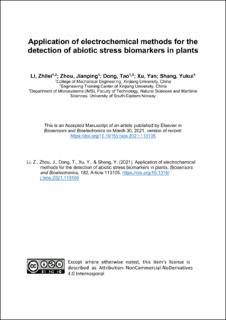| dc.contributor.author | Li, Zhilei | |
| dc.contributor.author | Zhou, Jianping | |
| dc.contributor.author | Dong, Tao | |
| dc.contributor.author | Xu, Yan | |
| dc.contributor.author | Shang, Yukui | |
| dc.date.accessioned | 2024-04-25T11:23:45Z | |
| dc.date.available | 2024-04-25T11:23:45Z | |
| dc.date.created | 2022-02-16T15:41:06Z | |
| dc.date.issued | 2021 | |
| dc.identifier.citation | Li, Z., Zhou, J., Dong, T., Xu, Y., & Shang, Y. (2021). Application of electrochemical methods for the detection of abiotic stress biomarkers in plants. Biosensors and Bioelectronics, 182, Artikkel 113105. | en_US |
| dc.identifier.issn | 0956-5663 | |
| dc.identifier.uri | https://hdl.handle.net/11250/3128099 | |
| dc.description.abstract | Abiotic stress is the main cause of low productivity in plants. Therefore, it is important to detect stress and respond to it in a timely manner to avoid irreversible damage to plant productivity and health. The application of traditional methods in agriculture is limited by expensive equipment and cumbersome sample processing. More effective detection methods are urgently needed due to the trace amounts and low stabilities of plant biomarkers. Electrochemical detection methods have the unique advantages of high accuracy, a low detection limit, fast response and easy integration with systems. In this review, the application of three types of electrochemical methods to phytohormone assessment is highlighted including direct electrochemical, immunoelectrochemical, and photoelectrochemical methods. Research on electrochemical methods for detecting abiotic stress biomarkers, including various phytohormones, is also summarized with examples. To date, the detection limit of exogenous plant hormones can reach pg/mL or even lower. Nevertheless, more efforts need to be made to develop a portable instrument for in situ online detection if electrochemical sensors are to be applied to the detection of the endogenous hormones or the physiological state of plants. Additionally, plant-wearable sensors that can be directly attached to or implanted into plants for continuous, noninvasive and real-time monitoring are emphasized. Finally, rational summaries of the considered methods and present challenges and future prospects in the field of abiotic stress detection-based electrochemical biosensors are thoroughly discussed. | en_US |
| dc.language.iso | eng | en_US |
| dc.rights | Attribution-NonCommercial-NoDerivatives 4.0 Internasjonal | * |
| dc.rights.uri | http://creativecommons.org/licenses/by-nc-nd/4.0/deed.no | * |
| dc.title | Application of electrochemical methods for the detection of abiotic stress biomarkers in plants | en_US |
| dc.type | Peer reviewed | en_US |
| dc.type | Journal article | en_US |
| dc.description.version | acceptedVersion | en_US |
| dc.source.volume | 182 | en_US |
| dc.source.journal | Biosensors & bioelectronics | en_US |
| dc.identifier.doi | https://doi.org/10.1016/j.bios.2021.113105 | |
| dc.identifier.cristin | 2002451 | |
| dc.source.articlenumber | 113105 | en_US |
| cristin.ispublished | true | |
| cristin.fulltext | postprint | |
| cristin.fulltext | preprint | |
| cristin.qualitycode | 1 | |

